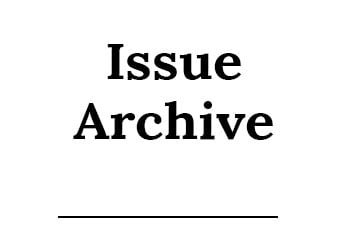There’s a bunch of fired up folks south of Penn.
Many days of the week, you can find them hanging in and around the old Liberty Fire Company No. 5 building at Fifth and Laurel streets.
These individuals are united in a cause – one that’s both tangible and teachable. And that cause, showcased in a solid brick and mortar late 19th-century structure, is known as the Reading Area Firefighters Museum, which they’ve been instrumental in creating.
Among those fired-up fellows are two retired City of Reading fire chiefs, William H. Rehr III, museum president, and Richard I. Boyer, a board member. And, living in the shadows of the “Liberties” (the building/company’s nickname) — in the neighborhood he’s always called home — is another retired fire chief and former president of the Liberties, William I. Stoudt. Sr.
It’s not the fire that blazes through these men’s veins. Rather, it’s the honor and devotion to the service of fighting fires and saving lives and properties that has defined their lives’ work and careers. And it’s something they are determined to share with the public.
On a mission
The Reading Area Firefighters Museum’s mission, they state, is to preserve, educate and exhibit the firefighting history of Berks County communities and the City of Reading. Rehr and Boyer are part of the 24-member board, half of which are very active volunteers.
“We are here two to four days a week working on the inside and the exterior,” says Boyer.
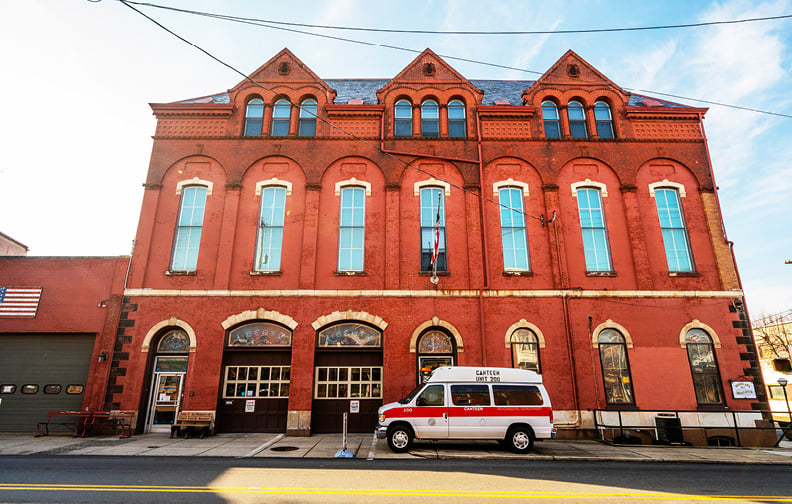
Rehr says there is a standing Thursday morning work detail. In addition, board members volunteer as docents when the museum is open to the public Thursdays from 9am to Noon and Saturdays 10am to 2pm. Other times may be available by appointment.
The fire service has been a way of life for generations of their families. When it comes to the history of the city, the Reading Fire Department predates American independence. It was formed March 17, 1773 as a volunteer fire department known as the Rainbow Volunteer Fire Company and is often acknowledged to be the oldest in the nation.
In 1854, the “Liberties” took occupancy in a building at Fifth and Laurel. In 1875, firefighters demolished the old firehouse and constructed a new two-story original building. In the 1890s, a third floor was added. The building remained under the Liberties ownership until late 2010 when it was sold to the city for $1 after a new fire station was constructed across the Bingaman Street Bridge on Lancaster Avenue in the 18th Ward.
The Liberties, even before the museum was established, was a city landmark. Every holiday season, the Victorian brick structure was outlined and illuminated by thousands of Christmas lights. Until just recently, it was home to the infamous LARK, a lumbering amphibious vehicle in service by the Reading Scuba Team for nearly half a century until it was retired in 2020.
Today, behind the large garage doors where the LARK roosted for so long, is a treasure trove of firefighting memorabilia, likely one of the most complete and authentic in the country.
Still standing by
The firefighters of 1854 still hold watch over the station – an extraordinary original collage featuring individual photos of each man is on the main floor museum. According to Rehr, the collage was restored a dozen years ago by the Conservation Center in south Philadelphia and its ornate frame by the Philadelphia Art Museum thanks to a grant secured by the late state Senator Michael A. O’Pake.
Rehr, Boyer and their colleagues have the back stories of almost every piece of equipment and memorabilia in the place. They value being able to share those stories with the thousands of visitors, including school children, who have toured the museum. Most recently, they hosted 400 Tyson-Schoener Elementary students and staff who took the short walk down S. Fifth Street to the museum. Children’s groups can view and experience a different type of tour and can be part of the teachable “Home Safety Awareness.”
Rehr says it’s fitting the neighborhood kids learn to love the museum as, it turns out, its creation was a labor of love initiated by the late Arline Ratajczak, the late Frank Bryson and by Chief Stoudt, Sr. The three long-time nearby residents were the backbone of the First Ward community group centered on the preservation of the local architecture, including the iconic fire station, from the 1980s into the 21st century.
With the blessing of the administration of former Mayor Tom McMahon, City Council and then-state Representative Thomas R. Caltagirone, who was able to secure a number of grants, by 2002 the museum really began to take shape. Just as volunteer firefighters constructed the building, their latter-day counterparts took active roles in its restoration and the collection and curation of local artifacts for the museum.
A hot tale and collection
As Rehr likes to say, the story of firefighting from the bucket brigades of the early 1700s to state-of-the-art engines and ladder trucks are showcased. Among the items featured are a 1771 broadside, salvage bag and bucket from the Union Fire Company No. 1 bucket brigade; 18th-century firefighters’ helmets; axes, hoses, firefighters apparel dating back more than two centuries; and scores of photographs, medals, lanterns and political posters. The posters were part of what Rehr calls “the beer and baloney” elections that started in 1867 for first fire chiefs and assistants. (Today, of course, promotions to these ranks are merit-based.)
Rehr, a dedicated volunteer with the Berks History Center, was instrumental in that institution’s donation of a large collection of firefighter helmets, buttons and badges.
The fire museum’s curator, John Trimble, spearheaded the effort to display the thousands of artifacts in an organized manner, grouping like objects together. That endeavor, with clear explanations of items, has greatly assisted in helping visitors understand the evolution of firefighting, from the bucket brigades to the present.
While each artifact has its own fascination factor, clearly the most popular attractions are the pumpers and engines displayed on the first floor. A circa 1770 Bernville fire pumper, small enough to easily fit inside a first-floor room, greets visitors as they enter the museum.
In the bay are three restored firefighting vehicles: a circa 1923 truck that replaced the last horse-drawn steam engine in Reading, the completely restored (off the frame – meaning taken entirely apart and restored to detail at a valuation of $195,000) 1931 Liberty Fire Company truck in service through 1966 (driven the last three years by Chief Stoudt Sr.), and the circa 1937 Pirsch truck. The latter, in service through the 1950s and 1960s, was a part of both Rehr’s and Boyer’s early years in the fire department.
“This is a part of our personal history,” says Boyer. “We can relate to it because we lived it.”
A recent addition (on loan) is a circa 1812 pumper (modernized in 1846 and 1851) owned by the Womelsdorf Fire Company. That joined a 1909 steam pumper, a 3.5-ton apparatus delivered in August 2020 from the Schuylkill County Fire Museum on loan there from the Berks History Center before being sold to the Reading museum.
Rehr and Boyer say these acquisitions/loans are evidence that the museum is a regional institution, hence the official name of the Reading Area Firefighters Museum.
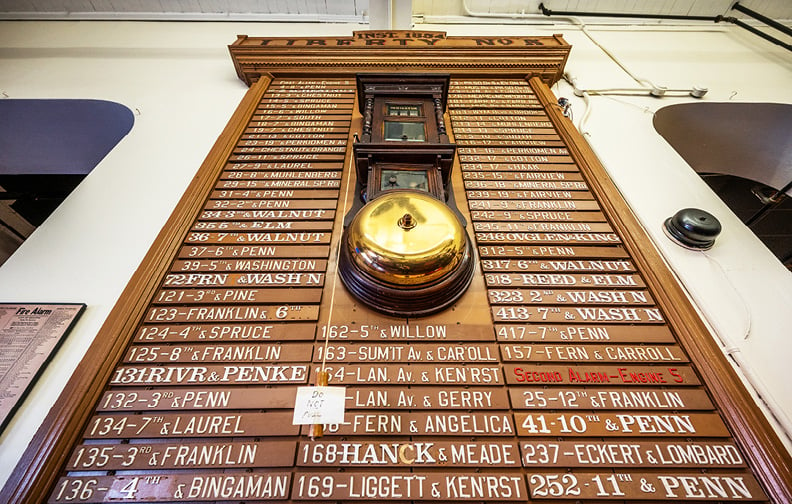
Being called to the scene
Also displayed in the bay is Box 109 from the Gamewell Fire System that served the city from 1873 until 1982. A pattern of rings that stroke in the fire stations told the companies where to respond to a working fire. For the most part, the strokes were memorized, but a sign posted nearby the boxes was a welcome assistant. In addition, the system was also in local newsrooms, enabling press to respond.
Rehr explains that it worked on the principal of the telegraph. Early on, dry cells at City Hall powered the system.
The Liberties, like many fire companies to this day, was a social destination. The third floor, added in the 1890s, was designed to provide a recreation/leisure space for the volunteer firefighters. The addition became a necessity with the constant swirl of activity, much of it centered in the spectacular second-floor Wanamaker Room.
Long before the local influence and philanthropy of the late Albert Boscov of the department store empire, there was another retail mogul by the name of John Wanamaker who counted among his Gilded Age society friends a number of Readingites in the fashionable downtown area.
At their urging, it is believed, he donated a number of furnishings he had displayed at the 1876 Centennial Exhibition in his hometown’s Fairmont Park to the Liberties. Those furnishings, intact and restored in the high-ceilinged room anchored by a huge and exquisite period chandelier, offer a glimpse to the ambiance moneyed Victorians experienced in the late 19th century.
Visitors to the Liberties have marveled at this room for years, but in 2014, it was at risk of destruction.
An 18-hour radiator steam leak in 2014 stripped the woodwork of its staining and heavily damaged the walls and much of the furnishings.
“Thankfully, almost everything survived that was under glass,” says Rehr, recalling his distress at witnessing the damage.
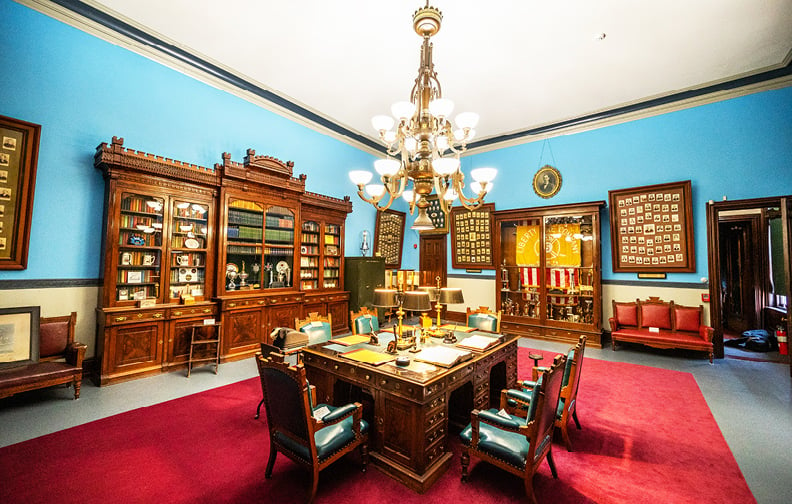
In good companies…
A $23,200 grant from the Building Industries Exchange of Reading through the Berks County Community Foundation helped with many of the repairs, particularly the woodwork, including the stairwell and wainscoting, and the walls. A successful call went out to the public for help in restoring the 19 damaged pieces of furniture. Individual sponsors stepped forward. Only four small sofas await restoration.
Rehr and Boyer praise the assistance of the local business community.
In 2016, Berkshire Systems completed donated equipment and installation (valued at $39,000) for the museum’s fire alarm and security system. The combined efforts of Berks Fire and Water Restoration, Yeager Supply and Essig Plumbing and Heating – at a cost in excess of $30,000 – resulted in the reconstruction and ADA accessibility of the old first-floor restrooms.
Also contributing to the building restoration was Gary Meals of Birdsboro whose Eagle Scout project involved a team to restore two basement rooms.
The magnificent third floor has also been restored, including a $10,000 restoration of the original maple wood floors and antique display cabinets donated by the Reading Public Museum. The original circa 1895 pool tables have also been restored, including – amazingly – the original billiard balls.
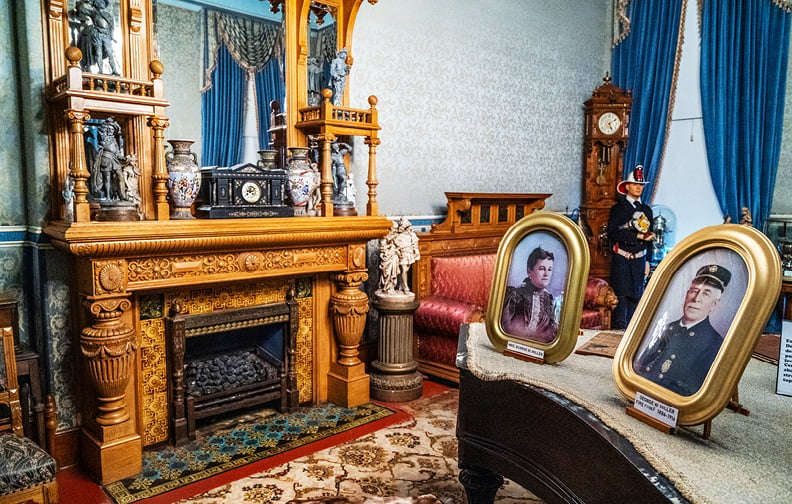
Many of the artifacts destined to be displayed in those third-floor cases have been temporarily moved to the first floor pending installation of an elevator in the southeast sector of the building. Restrictions placed by the city fire marshal keep the public from entering those top rooms. Local architects at Muhlenberg and Greene have designed the elevator as part of a $2 million updating project that calls for it as well as a new HVAC system.
The board is working with the city, the owner of the building, to make these capital repairs and investments, looking at possible ARPA funding as a part of the equation.
Rehr and Boyer take a great deal of pride in the praise lavished on the RAFM by museum professionals throughout the country. Some have come from California to volunteer. One Chicago fire museum official called it possibly the finest in the country.
Former Mayor McMahon agrees.
“They’ve made a name for themselves,” he says. “It’s one of the best examples of volunteerism for a long period of time in this area. If you go through the museum and see the material accumulated, you can see the real camaraderie and sharing between companies.”
Rehr and Boyer are hoping to enlist a younger generation of volunteers. One of them, perhaps, might be the city’s newest retired fire chief, William Stoudt, Jr., who from childhood, has had firefighting in his genes and his name.
“The Reading Fire Department, in many ways, has helped shaped the way the city looks today,” he says. “We’re out there every day and have been for more than two centuries. The more everyone understands how to stay safe, the more they understand what we do and our impact on Reading.”
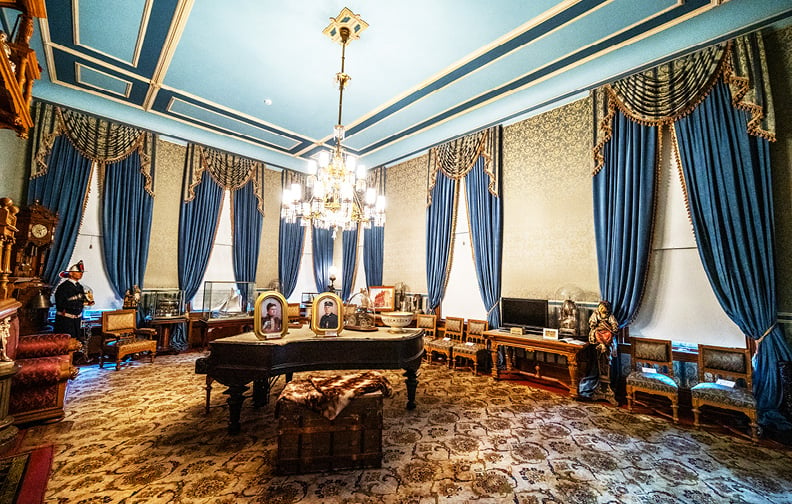
For more info:
readingareafirefightersmuseum.com
Editor’s note: Donna Reed is a member of Reading City Council and, in that capacity, has voted in the affirmative for policy and funding that has assisted the Reading Area Fire Museum operations.











